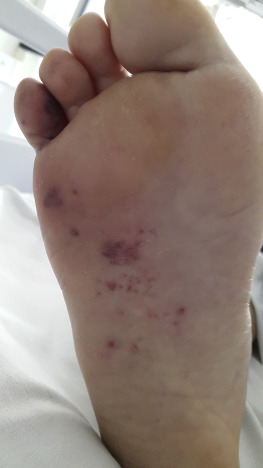A 72-year-old woman was admitted to our hospital with fever >38°C of unknown origin. Blood cultures were positive in two sets for Staphylococcus aureus . In the third day of admission, her husband drew attention to the presence of some small punctures in her right foot. Several small and non-tender, erythematous and hemorrhagic macular lesions were found on her sole (Janeway lesions). Besides, we detected some painful and palpable, erythematous nodules involving the pads of her toes (Osler nodes). At this point, according to the modified Duke criteria, the clinical diagnosis of definite infective endocarditis might be established. Additionally, the transesophageal echocardiogram just confirmed the presence of a large vegetation attached to the posterior leaflet of the mitral valve.
A 72-year-old woman was admitted to our hospital with fever >38°C of unknown origin. Blood cultures were positive in 2 sets for Staphylococcus aureus . In the third day of admission, her husband drew attention to the presence of some small punctures in her right foot ( Figure 1 ). Several small and nontender, erythematous, and hemorrhagic macular lesions were found on her sole (Janeway lesions). Besides, we detected some painful and palpable, erythematous nodules involving the pads of her toes (Osler nodes). At this point, according to the modified Duke criteria, the clinical diagnosis of definite infective endocarditis might be established. In addition, the transesophageal echocardiogram just confirmed the presence of a large vegetation attached to the posterior leaflet of the mitral valve.





